Principle of Financial Markets: Top-Down and Bottom-Up Analysis Report
VerifiedAdded on 2020/04/07
|20
|3342
|208
Report
AI Summary
This report conducts a comprehensive financial markets analysis, employing both top-down and bottom-up methodologies. It begins by assessing the macroeconomic environment of Australia, examining factors like GDP, interest rates, inflation, and exchange rates to evaluate the overall economic health. The analysis then narrows its focus to the energy industry, considered a promising sector within the Australian economy. The bottom-up analysis delves into the financial performance of two key companies, AGL Energy and Origin Energy, utilizing financial data from 2016 and 2017 to calculate and interpret key ratios. The report assesses profitability, capital structure, liquidity, and market performance, providing a detailed comparative analysis of the two companies within the context of the broader industry and economic conditions. This approach aims to provide insights into investment opportunities within the energy sector.

Principle of Financial Markets
1
1
Paraphrase This Document
Need a fresh take? Get an instant paraphrase of this document with our AI Paraphraser
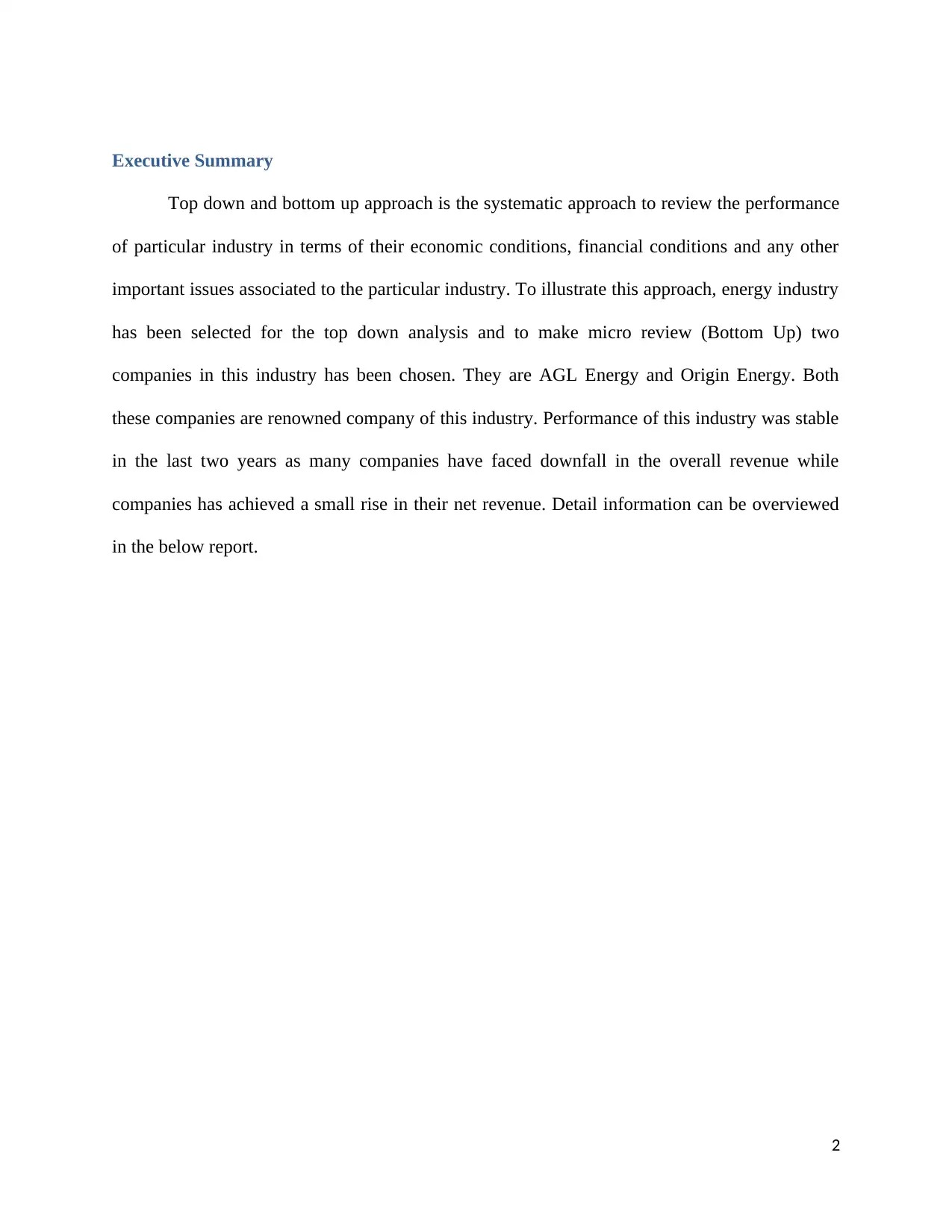
Executive Summary
Top down and bottom up approach is the systematic approach to review the performance
of particular industry in terms of their economic conditions, financial conditions and any other
important issues associated to the particular industry. To illustrate this approach, energy industry
has been selected for the top down analysis and to make micro review (Bottom Up) two
companies in this industry has been chosen. They are AGL Energy and Origin Energy. Both
these companies are renowned company of this industry. Performance of this industry was stable
in the last two years as many companies have faced downfall in the overall revenue while
companies has achieved a small rise in their net revenue. Detail information can be overviewed
in the below report.
2
Top down and bottom up approach is the systematic approach to review the performance
of particular industry in terms of their economic conditions, financial conditions and any other
important issues associated to the particular industry. To illustrate this approach, energy industry
has been selected for the top down analysis and to make micro review (Bottom Up) two
companies in this industry has been chosen. They are AGL Energy and Origin Energy. Both
these companies are renowned company of this industry. Performance of this industry was stable
in the last two years as many companies have faced downfall in the overall revenue while
companies has achieved a small rise in their net revenue. Detail information can be overviewed
in the below report.
2
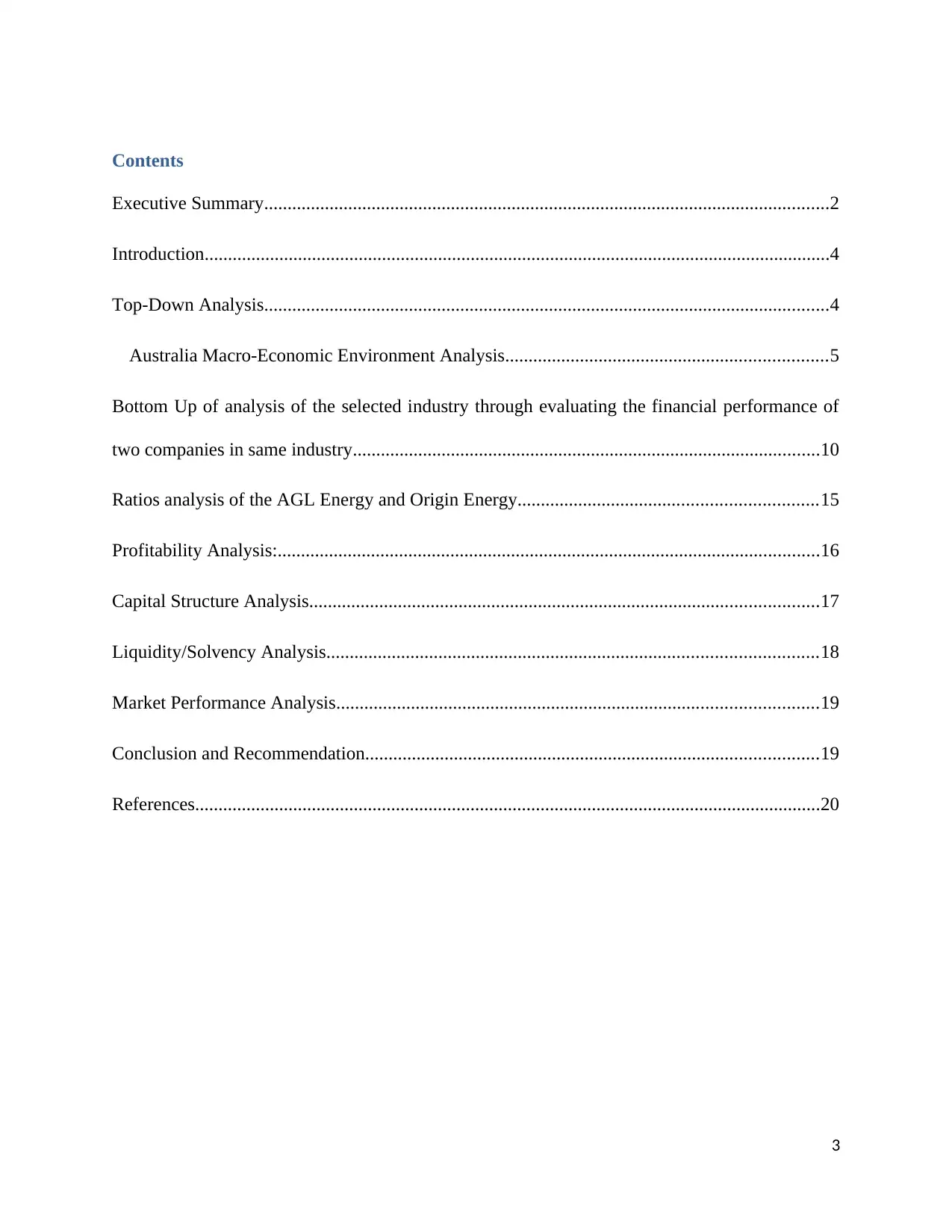
Contents
Executive Summary.........................................................................................................................2
Introduction......................................................................................................................................4
Top-Down Analysis.........................................................................................................................4
Australia Macro-Economic Environment Analysis.....................................................................5
Bottom Up of analysis of the selected industry through evaluating the financial performance of
two companies in same industry....................................................................................................10
Ratios analysis of the AGL Energy and Origin Energy................................................................15
Profitability Analysis:....................................................................................................................16
Capital Structure Analysis.............................................................................................................17
Liquidity/Solvency Analysis.........................................................................................................18
Market Performance Analysis.......................................................................................................19
Conclusion and Recommendation.................................................................................................19
References......................................................................................................................................20
3
Executive Summary.........................................................................................................................2
Introduction......................................................................................................................................4
Top-Down Analysis.........................................................................................................................4
Australia Macro-Economic Environment Analysis.....................................................................5
Bottom Up of analysis of the selected industry through evaluating the financial performance of
two companies in same industry....................................................................................................10
Ratios analysis of the AGL Energy and Origin Energy................................................................15
Profitability Analysis:....................................................................................................................16
Capital Structure Analysis.............................................................................................................17
Liquidity/Solvency Analysis.........................................................................................................18
Market Performance Analysis.......................................................................................................19
Conclusion and Recommendation.................................................................................................19
References......................................................................................................................................20
3
⊘ This is a preview!⊘
Do you want full access?
Subscribe today to unlock all pages.

Trusted by 1+ million students worldwide

Introduction
This report has been developed for demonstrating the importance of conducting
fundamental analysis for developing knowledge relating to the stocks performances for
investment purposes. The fundamental analysis aims to predict the capital gains that can be
realized from investing in a particular stock through evaluating the economic, financial,
qualitative and quantitative factors. The fundamental analysis is carried out through the adoption
of two approaches that are, bottom-up and top-down analysis. The report presents a top-down
and bottom-up analysis of the energy industry in Australia for identifying the economic factors
that impacts its performance. The companies selected for the purpose are two ASX listed energy
companies in Australia that are, AGL Energy Ltd and Origin Energy. The fundamental analysis
examines the underlying economic forces that impact the stock valuation of companies within a
selected industry. The top-down analysis examines the macro-economic forces impacting the
performance of the selected industry whereas micro-economic factors are examined under the
bottom-up analysis1.
Top-Down Analysis
The top-down analysis begins with primarily analyzing the global economic environment
conditions before selecting the particular securities for investing. As such, the analysis starts with
analyzing the broader economic environment and then narrowing down its approach to
examining the industry and the individual companies’ performance. The macro-economic
policies impacting the economic growth and development of a particular selected country is
1 Krantz, M. 2016. Fundamental Analysis For Dummies. John Wiley & Sons.
4
This report has been developed for demonstrating the importance of conducting
fundamental analysis for developing knowledge relating to the stocks performances for
investment purposes. The fundamental analysis aims to predict the capital gains that can be
realized from investing in a particular stock through evaluating the economic, financial,
qualitative and quantitative factors. The fundamental analysis is carried out through the adoption
of two approaches that are, bottom-up and top-down analysis. The report presents a top-down
and bottom-up analysis of the energy industry in Australia for identifying the economic factors
that impacts its performance. The companies selected for the purpose are two ASX listed energy
companies in Australia that are, AGL Energy Ltd and Origin Energy. The fundamental analysis
examines the underlying economic forces that impact the stock valuation of companies within a
selected industry. The top-down analysis examines the macro-economic forces impacting the
performance of the selected industry whereas micro-economic factors are examined under the
bottom-up analysis1.
Top-Down Analysis
The top-down analysis begins with primarily analyzing the global economic environment
conditions before selecting the particular securities for investing. As such, the analysis starts with
analyzing the broader economic environment and then narrowing down its approach to
examining the industry and the individual companies’ performance. The macro-economic
policies impacting the economic growth and development of a particular selected country is
1 Krantz, M. 2016. Fundamental Analysis For Dummies. John Wiley & Sons.
4
Paraphrase This Document
Need a fresh take? Get an instant paraphrase of this document with our AI Paraphraser
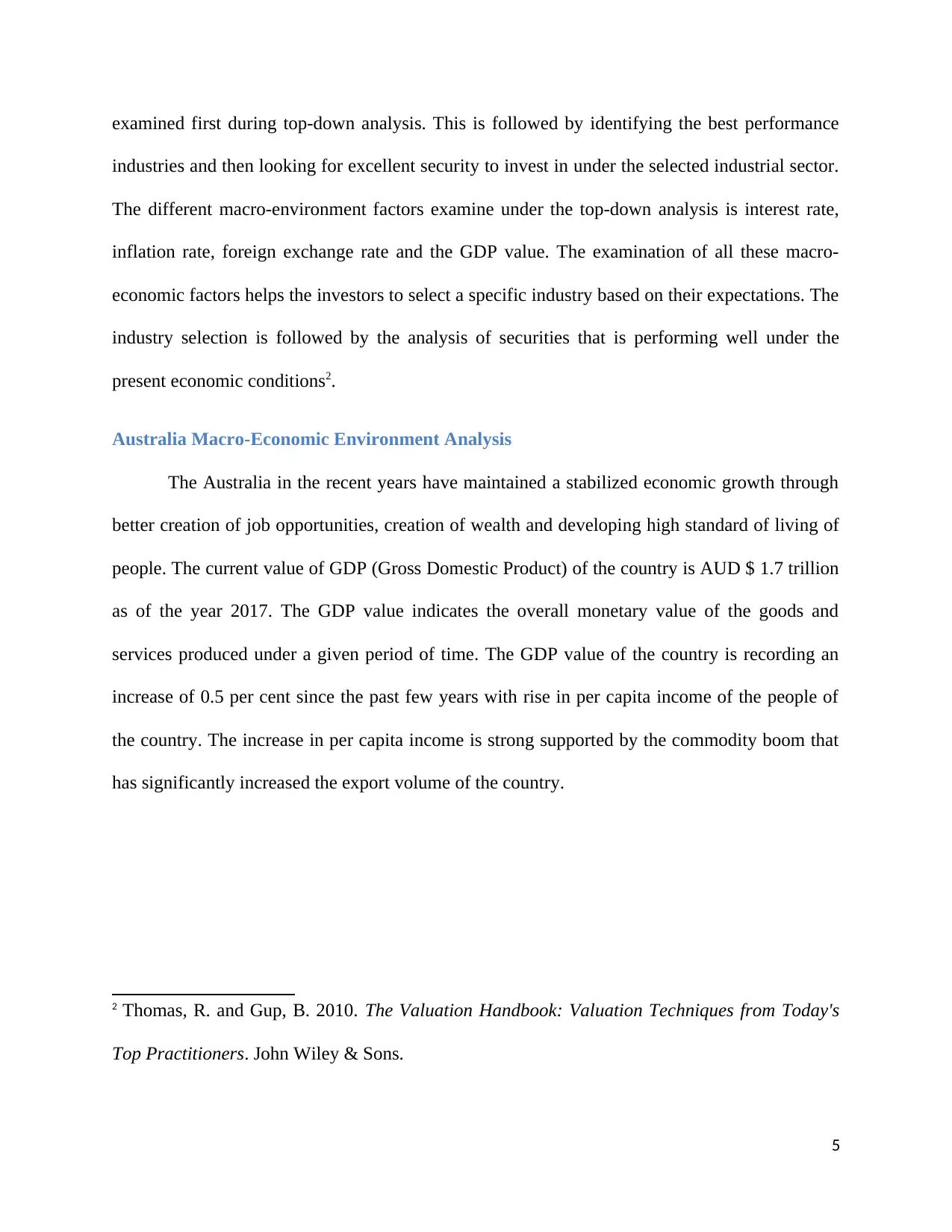
examined first during top-down analysis. This is followed by identifying the best performance
industries and then looking for excellent security to invest in under the selected industrial sector.
The different macro-environment factors examine under the top-down analysis is interest rate,
inflation rate, foreign exchange rate and the GDP value. The examination of all these macro-
economic factors helps the investors to select a specific industry based on their expectations. The
industry selection is followed by the analysis of securities that is performing well under the
present economic conditions2.
Australia Macro-Economic Environment Analysis
The Australia in the recent years have maintained a stabilized economic growth through
better creation of job opportunities, creation of wealth and developing high standard of living of
people. The current value of GDP (Gross Domestic Product) of the country is AUD $ 1.7 trillion
as of the year 2017. The GDP value indicates the overall monetary value of the goods and
services produced under a given period of time. The GDP value of the country is recording an
increase of 0.5 per cent since the past few years with rise in per capita income of the people of
the country. The increase in per capita income is strong supported by the commodity boom that
has significantly increased the export volume of the country.
2 Thomas, R. and Gup, B. 2010. The Valuation Handbook: Valuation Techniques from Today's
Top Practitioners. John Wiley & Sons.
5
industries and then looking for excellent security to invest in under the selected industrial sector.
The different macro-environment factors examine under the top-down analysis is interest rate,
inflation rate, foreign exchange rate and the GDP value. The examination of all these macro-
economic factors helps the investors to select a specific industry based on their expectations. The
industry selection is followed by the analysis of securities that is performing well under the
present economic conditions2.
Australia Macro-Economic Environment Analysis
The Australia in the recent years have maintained a stabilized economic growth through
better creation of job opportunities, creation of wealth and developing high standard of living of
people. The current value of GDP (Gross Domestic Product) of the country is AUD $ 1.7 trillion
as of the year 2017. The GDP value indicates the overall monetary value of the goods and
services produced under a given period of time. The GDP value of the country is recording an
increase of 0.5 per cent since the past few years with rise in per capita income of the people of
the country. The increase in per capita income is strong supported by the commodity boom that
has significantly increased the export volume of the country.
2 Thomas, R. and Gup, B. 2010. The Valuation Handbook: Valuation Techniques from Today's
Top Practitioners. John Wiley & Sons.
5
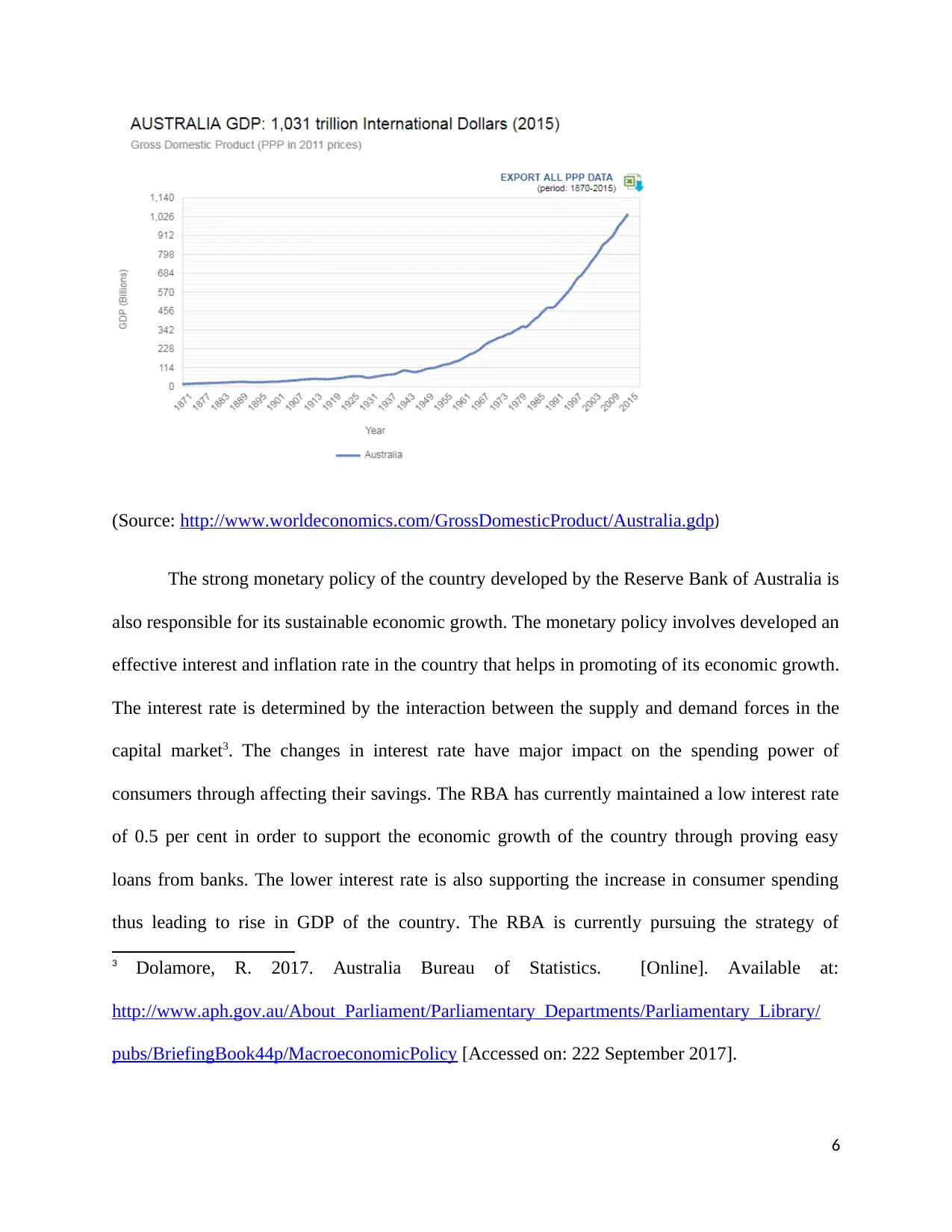
(Source: http://www.worldeconomics.com/GrossDomesticProduct/Australia.gdp)
The strong monetary policy of the country developed by the Reserve Bank of Australia is
also responsible for its sustainable economic growth. The monetary policy involves developed an
effective interest and inflation rate in the country that helps in promoting of its economic growth.
The interest rate is determined by the interaction between the supply and demand forces in the
capital market3. The changes in interest rate have major impact on the spending power of
consumers through affecting their savings. The RBA has currently maintained a low interest rate
of 0.5 per cent in order to support the economic growth of the country through proving easy
loans from banks. The lower interest rate is also supporting the increase in consumer spending
thus leading to rise in GDP of the country. The RBA is currently pursuing the strategy of
3 Dolamore, R. 2017. Australia Bureau of Statistics. [Online]. Available at:
http://www.aph.gov.au/About_Parliament/Parliamentary_Departments/Parliamentary_Library/
pubs/BriefingBook44p/MacroeconomicPolicy [Accessed on: 222 September 2017].
6
The strong monetary policy of the country developed by the Reserve Bank of Australia is
also responsible for its sustainable economic growth. The monetary policy involves developed an
effective interest and inflation rate in the country that helps in promoting of its economic growth.
The interest rate is determined by the interaction between the supply and demand forces in the
capital market3. The changes in interest rate have major impact on the spending power of
consumers through affecting their savings. The RBA has currently maintained a low interest rate
of 0.5 per cent in order to support the economic growth of the country through proving easy
loans from banks. The lower interest rate is also supporting the increase in consumer spending
thus leading to rise in GDP of the country. The RBA is currently pursuing the strategy of
3 Dolamore, R. 2017. Australia Bureau of Statistics. [Online]. Available at:
http://www.aph.gov.au/About_Parliament/Parliamentary_Departments/Parliamentary_Library/
pubs/BriefingBook44p/MacroeconomicPolicy [Accessed on: 222 September 2017].
6
⊘ This is a preview!⊘
Do you want full access?
Subscribe today to unlock all pages.

Trusted by 1+ million students worldwide
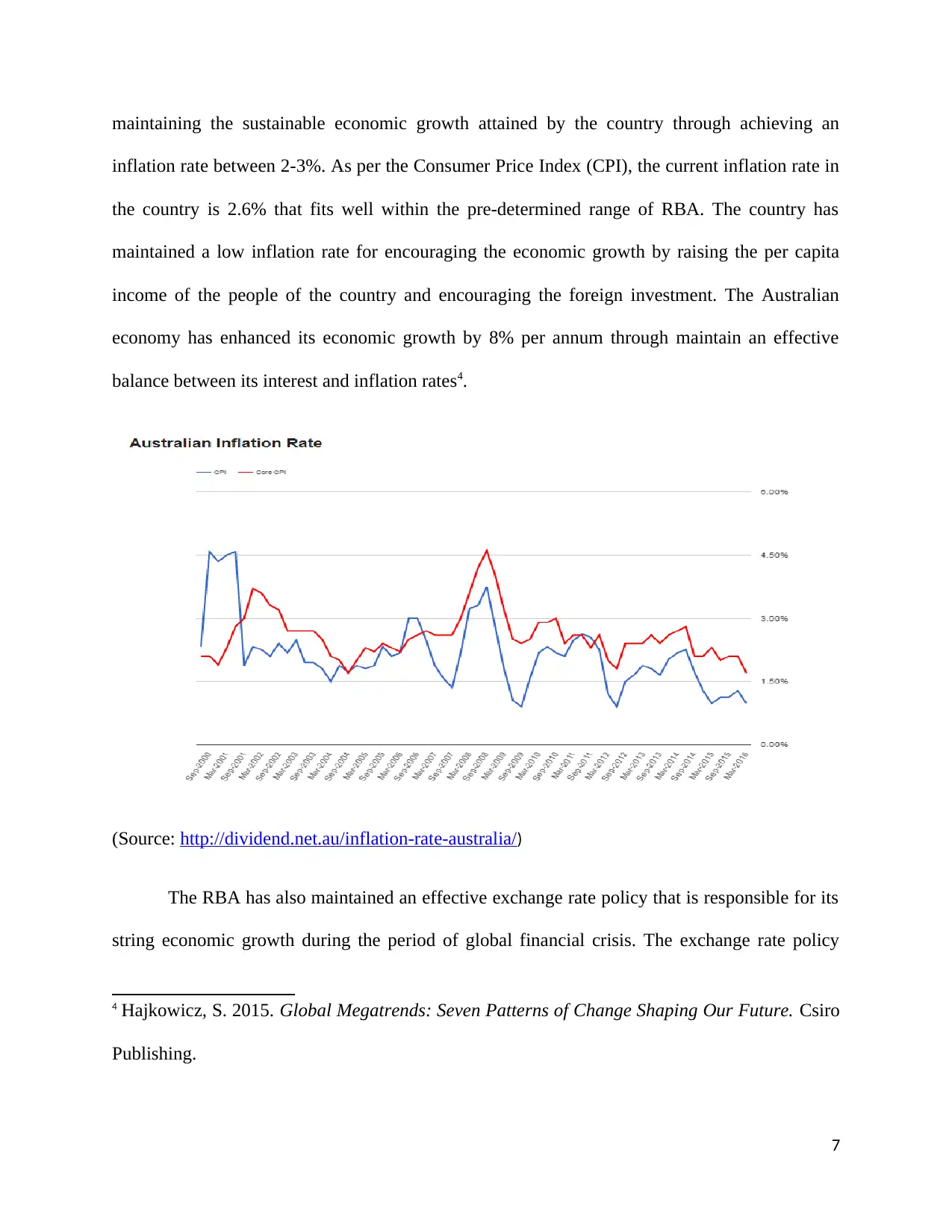
maintaining the sustainable economic growth attained by the country through achieving an
inflation rate between 2-3%. As per the Consumer Price Index (CPI), the current inflation rate in
the country is 2.6% that fits well within the pre-determined range of RBA. The country has
maintained a low inflation rate for encouraging the economic growth by raising the per capita
income of the people of the country and encouraging the foreign investment. The Australian
economy has enhanced its economic growth by 8% per annum through maintain an effective
balance between its interest and inflation rates4.
(Source: http://dividend.net.au/inflation-rate-australia/)
The RBA has also maintained an effective exchange rate policy that is responsible for its
string economic growth during the period of global financial crisis. The exchange rate policy
4 Hajkowicz, S. 2015. Global Megatrends: Seven Patterns of Change Shaping Our Future. Csiro
Publishing.
7
inflation rate between 2-3%. As per the Consumer Price Index (CPI), the current inflation rate in
the country is 2.6% that fits well within the pre-determined range of RBA. The country has
maintained a low inflation rate for encouraging the economic growth by raising the per capita
income of the people of the country and encouraging the foreign investment. The Australian
economy has enhanced its economic growth by 8% per annum through maintain an effective
balance between its interest and inflation rates4.
(Source: http://dividend.net.au/inflation-rate-australia/)
The RBA has also maintained an effective exchange rate policy that is responsible for its
string economic growth during the period of global financial crisis. The exchange rate policy
4 Hajkowicz, S. 2015. Global Megatrends: Seven Patterns of Change Shaping Our Future. Csiro
Publishing.
7
Paraphrase This Document
Need a fresh take? Get an instant paraphrase of this document with our AI Paraphraser
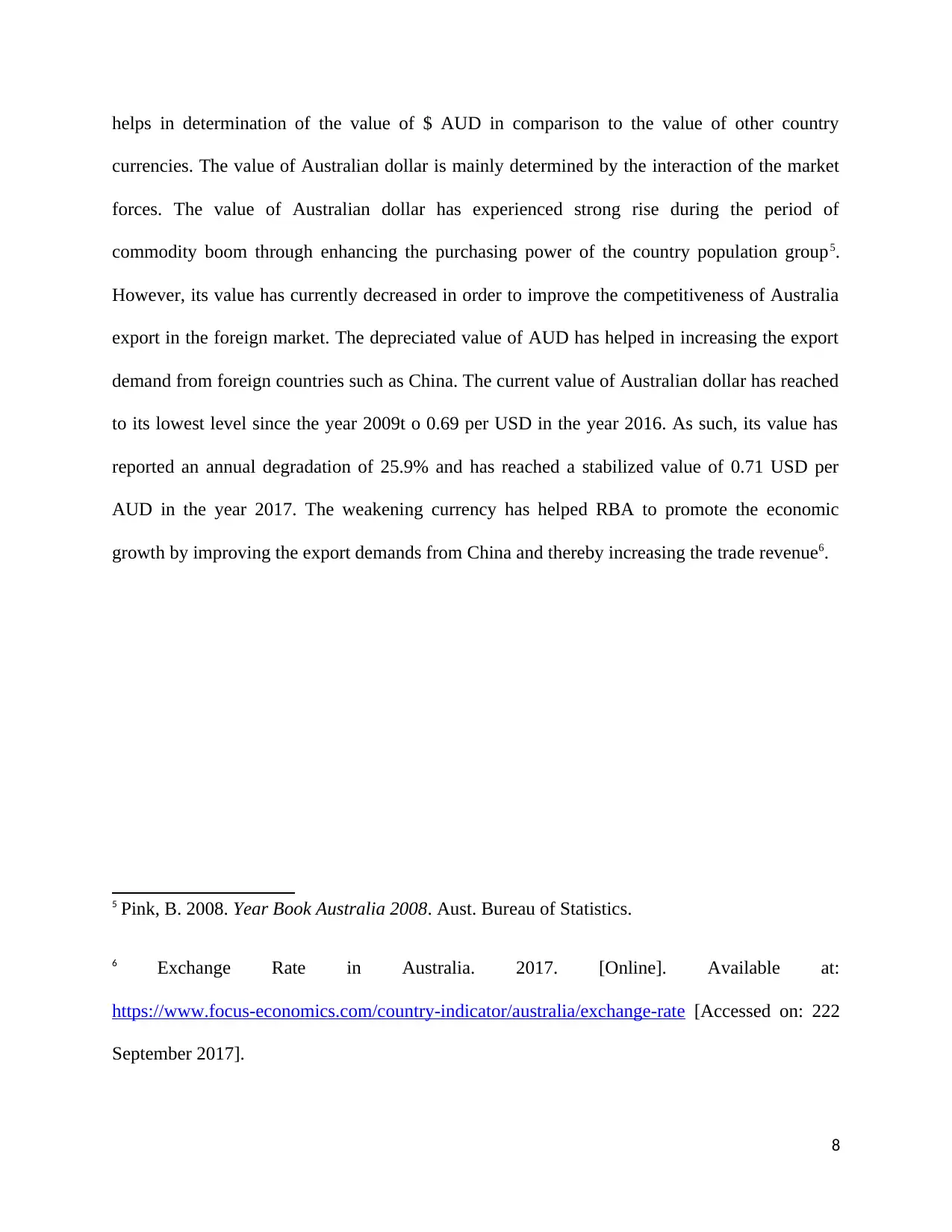
helps in determination of the value of $ AUD in comparison to the value of other country
currencies. The value of Australian dollar is mainly determined by the interaction of the market
forces. The value of Australian dollar has experienced strong rise during the period of
commodity boom through enhancing the purchasing power of the country population group5.
However, its value has currently decreased in order to improve the competitiveness of Australia
export in the foreign market. The depreciated value of AUD has helped in increasing the export
demand from foreign countries such as China. The current value of Australian dollar has reached
to its lowest level since the year 2009t o 0.69 per USD in the year 2016. As such, its value has
reported an annual degradation of 25.9% and has reached a stabilized value of 0.71 USD per
AUD in the year 2017. The weakening currency has helped RBA to promote the economic
growth by improving the export demands from China and thereby increasing the trade revenue6.
5 Pink, B. 2008. Year Book Australia 2008. Aust. Bureau of Statistics.
6 Exchange Rate in Australia. 2017. [Online]. Available at:
https://www.focus-economics.com/country-indicator/australia/exchange-rate [Accessed on: 222
September 2017].
8
currencies. The value of Australian dollar is mainly determined by the interaction of the market
forces. The value of Australian dollar has experienced strong rise during the period of
commodity boom through enhancing the purchasing power of the country population group5.
However, its value has currently decreased in order to improve the competitiveness of Australia
export in the foreign market. The depreciated value of AUD has helped in increasing the export
demand from foreign countries such as China. The current value of Australian dollar has reached
to its lowest level since the year 2009t o 0.69 per USD in the year 2016. As such, its value has
reported an annual degradation of 25.9% and has reached a stabilized value of 0.71 USD per
AUD in the year 2017. The weakening currency has helped RBA to promote the economic
growth by improving the export demands from China and thereby increasing the trade revenue6.
5 Pink, B. 2008. Year Book Australia 2008. Aust. Bureau of Statistics.
6 Exchange Rate in Australia. 2017. [Online]. Available at:
https://www.focus-economics.com/country-indicator/australia/exchange-rate [Accessed on: 222
September 2017].
8

Source: http://www.marketindex.com.au/australian-dollar
The strong economic growth attained by Australia in the current years is on account of its
strong industrial production as indicated by increase in its GDP value in the recent years. The
strong financial performance of its mining, agriculture and service sector has improved the
economic conditions in the country. The large-scale production and export of coal from Australia
has promotes strong growth in its energy sector as well. It is estimated by the financial analysts
in the country that the energy market of the country is expected to record an increase of 8.7%
from its present value till the end of the year 2022. As such, the presence of high-quality energy
resources within the country provides a positive sign of future growth in the energy sector of the
country. The country is recognized to be accounting for 2.5% of the total energy produced across
the world and contributes strongly to its economic growth. The price of energy products is on
9
The strong economic growth attained by Australia in the current years is on account of its
strong industrial production as indicated by increase in its GDP value in the recent years. The
strong financial performance of its mining, agriculture and service sector has improved the
economic conditions in the country. The large-scale production and export of coal from Australia
has promotes strong growth in its energy sector as well. It is estimated by the financial analysts
in the country that the energy market of the country is expected to record an increase of 8.7%
from its present value till the end of the year 2022. As such, the presence of high-quality energy
resources within the country provides a positive sign of future growth in the energy sector of the
country. The country is recognized to be accounting for 2.5% of the total energy produced across
the world and contributes strongly to its economic growth. The price of energy products is on
9
⊘ This is a preview!⊘
Do you want full access?
Subscribe today to unlock all pages.

Trusted by 1+ million students worldwide

increase in the country with its large-scale domestic use. The use of energy by the domestic
population of the country is on increase in the recent years with the growth in population7.
The natural gas and electricity represents high usage of about 24 % and 22% of the
overall energy use in the country. The government of the country is also placing strong focus on
promoting the growth of the energy industry of the country also plays a vital role in improving
its GDP. The government is incorporating the use of modern technological measures for
reducing the pollution from the energy sector of the country. This is done mainly to promote the
development of clean energy technologies that does not have any impact on the environment
quality. This is done for ensuring the long-term growth of the energy sector of the country by
ensuring the industry compliance with the standard guidelines provided under Kyoto Protocol.
Also, the government is emphasizing on the production of energy products from renewable
sources such as hydro and wind with the exhaustion of non-renewable sources such as coal8. The
increase of energy consumption in Australia in the recent year clearly represents a positive sign
for the investors. The investors are recommend to invest in the energy sector under the present
7 Slezak, M. 2017. Energy economics group says export market for Australian coal will decline.
[Online]. Available at: https://www.theguardian.com/environment/2017/jul/12/energy-
economics-group-says-export-market-for-australian-coal-will-decline [Accessed on: 222
September 2017].
8 Australian Environmental-Economic Accounts. 2017. [Online]. Available at:
http://www.abs.gov.au/ausstats/abs@.nsf/Products/4655.0.55.002~2013~Main+Features~Chapte
r+3+Energy?OpenDocument [Accessed on: 222 September 2017].
10
population of the country is on increase in the recent years with the growth in population7.
The natural gas and electricity represents high usage of about 24 % and 22% of the
overall energy use in the country. The government of the country is also placing strong focus on
promoting the growth of the energy industry of the country also plays a vital role in improving
its GDP. The government is incorporating the use of modern technological measures for
reducing the pollution from the energy sector of the country. This is done mainly to promote the
development of clean energy technologies that does not have any impact on the environment
quality. This is done for ensuring the long-term growth of the energy sector of the country by
ensuring the industry compliance with the standard guidelines provided under Kyoto Protocol.
Also, the government is emphasizing on the production of energy products from renewable
sources such as hydro and wind with the exhaustion of non-renewable sources such as coal8. The
increase of energy consumption in Australia in the recent year clearly represents a positive sign
for the investors. The investors are recommend to invest in the energy sector under the present
7 Slezak, M. 2017. Energy economics group says export market for Australian coal will decline.
[Online]. Available at: https://www.theguardian.com/environment/2017/jul/12/energy-
economics-group-says-export-market-for-australian-coal-will-decline [Accessed on: 222
September 2017].
8 Australian Environmental-Economic Accounts. 2017. [Online]. Available at:
http://www.abs.gov.au/ausstats/abs@.nsf/Products/4655.0.55.002~2013~Main+Features~Chapte
r+3+Energy?OpenDocument [Accessed on: 222 September 2017].
10
Paraphrase This Document
Need a fresh take? Get an instant paraphrase of this document with our AI Paraphraser

economic conditions of Australia that are in favor of strong financial performance of the energy
sector in the coming period of time. The AGL Energy Limited is the major energy company
within the Australia having largest market capitalization in terms of revenues as compared to
other energy companies of the country. On the other hand, Origin Energy is also reporting strong
financial growth in the energy sector in the recent years. As such, the top-down analysis of the
Australia has suggested that investors should invest in the energy sector of the country with
evaluating the stock performance of AGL and Origin Energy within the sector. This will help the
top-down investors to identify the correct stock for investment purpose. The analysis of the
financial performance of the selected companies can be done through bottom-up analysis9.
9 Energy White Paper – April 2015. 2015. [Online]. Available at:
https://industry.gov.au/EnergyWhitePaperApril2015/index.html [Accessed on: 222 September
2017].
11
sector in the coming period of time. The AGL Energy Limited is the major energy company
within the Australia having largest market capitalization in terms of revenues as compared to
other energy companies of the country. On the other hand, Origin Energy is also reporting strong
financial growth in the energy sector in the recent years. As such, the top-down analysis of the
Australia has suggested that investors should invest in the energy sector of the country with
evaluating the stock performance of AGL and Origin Energy within the sector. This will help the
top-down investors to identify the correct stock for investment purpose. The analysis of the
financial performance of the selected companies can be done through bottom-up analysis9.
9 Energy White Paper – April 2015. 2015. [Online]. Available at:
https://industry.gov.au/EnergyWhitePaperApril2015/index.html [Accessed on: 222 September
2017].
11

(Sources: https://industry.gov.au/EnergyWhitePaperApril2015/index.html)
Bottom Up of analysis of the selected industry through evaluating the financial
performance of two companies in same industry
In this part micro analysis of the energy sector in Australia will be analyzed in terms of
their financial performance. Bottom up analysis aims to review the individuals stocks in the
industry and makes comments upon the company financial performance in order to evaluate the
industrial performance as a whole. In this part, companies that are selected are AGL Energy and
Origin Energy. In order to make comments on the financial performance of the selected
companies, ratio analysis has been performed for the years 2016 and 2017. Financial data has
been taken from the annual reports published at their websites. Below tables will the details of
financial data and calculation of ratios10.
Financial Data of AGL Energy (Amount in Million Dollar)
Particulars 2016 2017
Net Profit
$
(407.00)
$
539.00
Total Assets
$
14,604.00
$
14,458.00
Net Revenue
$
11,150.00
$
12,359.00
10 Bull, R. 2007. Financial Ratios: How to use financial ratios to maximize value and success for
your businesses. Elsevier.
12
Bottom Up of analysis of the selected industry through evaluating the financial
performance of two companies in same industry
In this part micro analysis of the energy sector in Australia will be analyzed in terms of
their financial performance. Bottom up analysis aims to review the individuals stocks in the
industry and makes comments upon the company financial performance in order to evaluate the
industrial performance as a whole. In this part, companies that are selected are AGL Energy and
Origin Energy. In order to make comments on the financial performance of the selected
companies, ratio analysis has been performed for the years 2016 and 2017. Financial data has
been taken from the annual reports published at their websites. Below tables will the details of
financial data and calculation of ratios10.
Financial Data of AGL Energy (Amount in Million Dollar)
Particulars 2016 2017
Net Profit
$
(407.00)
$
539.00
Total Assets
$
14,604.00
$
14,458.00
Net Revenue
$
11,150.00
$
12,359.00
10 Bull, R. 2007. Financial Ratios: How to use financial ratios to maximize value and success for
your businesses. Elsevier.
12
⊘ This is a preview!⊘
Do you want full access?
Subscribe today to unlock all pages.

Trusted by 1+ million students worldwide
1 out of 20
Related Documents
Your All-in-One AI-Powered Toolkit for Academic Success.
+13062052269
info@desklib.com
Available 24*7 on WhatsApp / Email
![[object Object]](/_next/static/media/star-bottom.7253800d.svg)
Unlock your academic potential
Copyright © 2020–2025 A2Z Services. All Rights Reserved. Developed and managed by ZUCOL.





